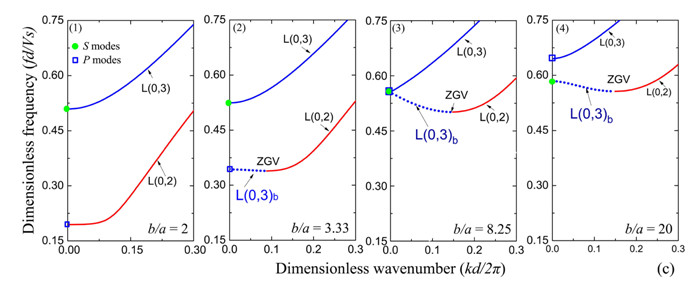
Characteristics of Group Velocities of Backward Waves in a Hollow Cylinder Investigated to Design an Acoustic Isolator
Jun 12, 2014 Email"> PrintText Size

A backward wave refers to a wave for which the phase and group velocities are oppositely directed. Applications of backward wave motions of Lamb waves in plate structures have been explored. For example, acoustic superlens investigations applying the backward-propagation effect; and the non-contact, laser-based nondestructive evaluation and material characterization techniques that are using zero-group-velocity resonances of backward Lamb modes.
Generally, a large group velocity and a wide range of frequencies over which the backward mode exists (i.e., the backward-propagation effect is strong) is often required for the purpose of designing new acoustic devices utilizing backward waves. For elastic plates, group velocities of backward Lamb waves depend only on Poisson’s ratio.
Researchers from the Institute of Acoustics, Chinese Academy of Sciences and the Durham University (UK) cooperate to explore ways of achieving a large group velocity of a backward mode in hollow cylinders by changing the outer to inner radius ratio, in order that such a mode with strong backward-propagation characteristics may be used in acoustic logging tools.
It seeks to design an acoustic isolator with high mechanical strength, instead of using the grooved structure, so that the tool can function well during drilling. The proposed method is to decrease the propagation velocities of the tool waves by applying the interference effects of backward-and forward- propagating tool waves propagating along the cylindrical collar, in order to separate the formation arrivals from the delayed tool waves.
Analyses of group velocity characteristics show that only a small number of low order backward modes are suitable for practical use, and the radius ratio to reach the highest group velocity corresponds to the accidental degeneracy of neighboring pure transverse and compressional modes at the wavenumber k = 0. It is also shown that large group velocities of backward waves are achievable in hollow cylinders made of commonly encountered materials, which may bring cost benefits when using acoustic devices which take advantage of backward-propagation effects.

Fig. 1 The interactions between the L(0,2) and L(0,3) modes in four nickel pipes with radius radios b/a = 2, 3.33, 8.25, and 20, respectively, are shown in figures (1-4). The solid and dotted lines represent the forward and backward modes, respectively (Image by CUI).
Journal References:
Hanyin Cui, Weijun Lin, Hailan Zhang, Xiuming Wang, and Jon Trevelyan. Characteristics of Group Velocities of Backward Waves in a Hollow Cylinder. J. Acoust. Soc. Am. (vol.135, no.6, pp. 3398-3408, 2014). http://dx.doi.org/10.1121/1.4872297
Contact:
CUI Hanyin
State Key Laboratory of Acoustics, Institute of Acoustics, Chinese Academy of Science, Beijing 100190, China
E-mail: cuihanyin@mail.ioa.ac.cn
A backward wave refers to a wave for which the phase and group velocities are oppositely directed. Applications of backward wave motions of Lamb waves in plate structures have been explored. For example, acoustic superlens investigations applying the backward-propagation effect; and the non-contact, laser-based nondestructive evaluation and material characterization techniques that are using zero-group-velocity resonances of backward Lamb modes.
Generally, a large group velocity and a wide range of frequencies over which the backward mode exists (i.e., the backward-propagation effect is strong) is often required for the purpose of designing new acoustic devices utilizing backward waves. For elastic plates, group velocities of backward Lamb waves depend only on Poisson’s ratio.
Researchers from the Institute of Acoustics, Chinese Academy of Sciences and the Durham University (UK) cooperate to explore ways of achieving a large group velocity of a backward mode in hollow cylinders by changing the outer to inner radius ratio, in order that such a mode with strong backward-propagation characteristics may be used in acoustic logging tools.
It seeks to design an acoustic isolator with high mechanical strength, instead of using the grooved structure, so that the tool can function well during drilling. The proposed method is to decrease the propagation velocities of the tool waves by applying the interference effects of backward-and forward- propagating tool waves propagating along the cylindrical collar, in order to separate the formation arrivals from the delayed tool waves.
Analyses of group velocity characteristics show that only a small number of low order backward modes are suitable for practical use, and the radius ratio to reach the highest group velocity corresponds to the accidental degeneracy of neighboring pure transverse and compressional modes at the wavenumber k = 0. It is also shown that large group velocities of backward waves are achievable in hollow cylinders made of commonly encountered materials, which may bring cost benefits when using acoustic devices which take advantage of backward-propagation effects.

Fig. 1 The interactions between the L(0,2) and L(0,3) modes in four nickel pipes with radius radios b/a = 2, 3.33, 8.25, and 20, respectively, are shown in figures (1-4). The solid and dotted lines represent the forward and backward modes, respectively (Image by CUI).
Journal References:
Hanyin Cui, Weijun Lin, Hailan Zhang, Xiuming Wang, and Jon Trevelyan. Characteristics of Group Velocities of Backward Waves in a Hollow Cylinder. J. Acoust. Soc. Am. (vol.135, no.6, pp. 3398-3408, 2014). http://dx.doi.org/10.1121/1.4872297
Contact:
CUI Hanyin
State Key Laboratory of Acoustics, Institute of Acoustics, Chinese Academy of Science, Beijing 100190, China
E-mail: cuihanyin@mail.ioa.ac.cn
CAS Institutes
There are 124 Institutions directly under the CAS by the end of 2012, with 104 research institutes, five universities & supporting organizations, 12 management organizations that consist of the headquarters and branches, and three other units. Moreover, there are 25 legal entities affiliated and 22 CAS invested holding enterprisesThere are 124 I...>> more
Contact Us

Chinese Academy of Sciences
Add: 52 Sanlihe Rd., Xicheng District, Beijing, China
Postcode: 100864
Tel: 86-10-68597592 (day) 86-10-68597289 (night)
Fax: 86-10-68511095 (day) 86-10-68512458 (night)
E-mail: cas_en@cas.cn

